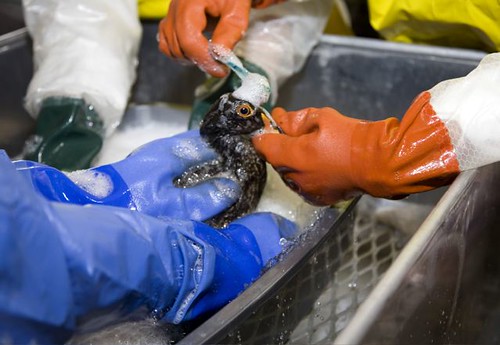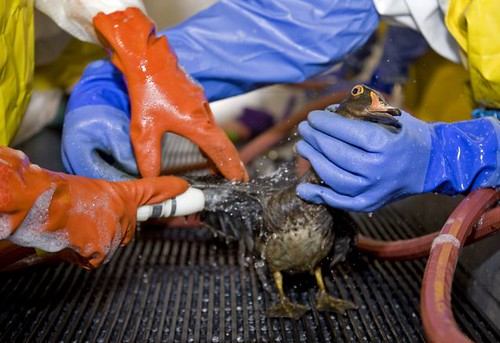(9AM – promoted by RiaD)
Four birds. In a 100 mile oil slick, stretching from New Orleans to the Gulf of Mexico,
at this time, four birds were captured for cleaning: a cattle egret, two ducks, a juvenile laughing gull, and one turtle. Oh, a snake was caught covered with oil, but it was tossed out by cleanup workers.
I attended a cleaning of three of the birds in Venice, Louisiana, about two hours outside of New Orleans towards the Gulf of Mexico. They use Dawn detergent, because it cuts grease. The Exxon- Valdez spill taught us that Dawn is effective.

Photos are by Julie Dermansky, who has been covering the spill from the beginning. I was lucky to stumble onto her.

Workers from the Wildlife Rehab and Education Agency out of Houston set up three soapy tubs. First cleaned was a juvenile Laughing Gull. Sharon Schmalz, Wildlife Rehabilitator and Oiled Wildlife Responder (she’s been doing this for 25 years), said they will know if the scrubbing is successful, because when the bird is rinsed, water will bead off of the feathers.
After the scrubbing, while being rinsed, Sharon pointed out the water was beading up as it dripped off the feather of the gull. They wisked that bird away after the cleaning. Then they worked on a Green-Winged Teal Duck. The terrified bird seemed to gaze out at me as I watched. The birds struggle, but are handled gently and expertly.
The scrubbing was successful. The water beaded nicely off of the feathers as they rinsed the duck. The beautiful, blue-green feathers were suddenly visible. Watching, I feel as though I am visitor to a sacred ceremony. The terrified wildness of the birds, panicked eyes. The expert, gentle but vigorous scrubbing. The ritual-like three soapy tubs, then the rinse.

The obvious vulnerability of the oil-soaked birds causes tears to rise; how do you say you are sorry to a wild creature?
The Green-Winged Teal Duck was placed in a temporary wood cage with an orange heat lamp inside. I watched through a crack in the corner of the cage as the now visibly relieved duck began to preen feathers. Sharon said the preening is a sure sign that the oil has been successfully removed, and now the birds are anxious to get their feathers back in shape.
Bill Starkel with the United States Wildlife and Fisheries Service is there at the cleaning. He said four to six boats are being used to look for wildlife by his agency and others working in tandem. For a 100 mile stretch of Mississippi River, much of it wild on the banks, just 4 to 6 boats. A few people on the levees with trucks were also looking, he said.
We were told at last Thursday’s press conference, that oiled animals weaken, and become easier to find after a period of time has passed. Now it is nearly two weeks since the spill. Four birds, a turtle, and a snake tossed out before it can be cleaned.
Today I spoke to Adam Baylor with the Public Relations Department of the Coast Guard. We met on the riverfront, in front of the Port Authority building, with a perfect side view of workers that are fastening cables to the partially submerged barge.
Baylor said, “You know how hard it is to catch oiled wildlife under these circumstances?”
“No”, I say.
These animals are on the river’s edge, he explains, and with the marsh extending from the river outward, the animals can simply disappear into the marsh.
I’m not satisfied with this explanation though. The animals are supposed to be weakened by now, and easier to reach. That’s what we were told. A 100 mile slick, and just a hand full of oiled creatures.
I ask another question. Why wasn’t there preparation for another oil spill, if the Coast Guard and federal officials were so sure there would be additional oil spilled? Another 2500 gallons of fuel oil made it into the river and fouled already fouled river banks this past Thursday.
“You see this containment boom, ” Baylor said, pointing along the length of the boom from the submerged barge downriver a couple hundred feet to a huge barge parked not far from the river bank.
“That containment boom was there when the additional oil spilled,” Baylor said. “What was missing was that barge.”
The huge barge is the HOSS Barge, owned by Clean Gulf Associates. It is a high volume, oil skimming system, constructed for oceanic uses. It was parked in Houma, Louisiana, about 65 miles west of New Orleans. It took 18 hours to be towed to New Orleans, and it arrived the morning just hours after the second oil spill, on Thursday, July 31st.
“When did the request go out for the HOSS Barge to come here?” I asked.
“I can’t answer that question, Mam,” said Baylor.
Hours later, as I sit and ponder his response, I realize the vulnerability of our river to oil spills: the equipment needed to contain a spill this large is miles away. It might as well be days or weeks away as a spill is carried quickly downriver by this fast moving current.
Today the Times Picayune carried audio of the initial, panicked conversation by the pilot of the tanker Tintomara, as he and others unsuccessfully tried to alert the tugboat Mel Oliver.
They need to get a containment over here for oil fuel,” said one man checking out the scene a few minutes after the collision. “They got fuel all over the freakin’ river now.”
It would be days before the HOSS Barge would arrive to be used to contain the spill.
I keep thinking back to my conversation with colleagues after we viewed the oiled birds. I told them, “I feel as though this was theater.” One colleague agreed with me.
Catch a few birds, stage a feel-good cleaning for limited, public viewing. And here’s where my cynicism cuts in. Can’t have too many birds, because then the public may become more interested as to the true extent of this spill.
I think back to one of the comments left after my last diary on this issue. This commentator said, like the Iraq war, can’t show too many pictures that might reveal the true nature of this dirty, ugly oil business. Carefully controlled media access, with staged events, allows for greater control of the overall issue.
Too many helpless creatures covered with oil just might turn a weary public against the concept of further drilling to attempt to meet our oil needs. This is not just about McCain losing a photo-op.
In looking inside the terrified gaze of an oiled bird, I found myself feeling strangely calm and clear minded. Choices become clear. Answers reveal themselves. They aren’t easy answers.
If we don’t create the political climate for clean fuel, who will?
Efforts are currently under way to drain the remaining oil, what could be 10,000 gallons of the fuel oil from the submerged barge, before it is lifted out of the river. I’ll have an update tomorrow.

6 comments
Skip to comment form
thank you.
walk into this bar….
Goddess, how I wish this was just a setup to a joke, even a bad joke.
Perhaps, if we work at it, this sort of thing won’t happen in the future and will fade from memory like The Cuyahoga River Fire of 1969.
Yes, Cleveland (an ex-resident friend calls it “the mistake on the lake”) has a river with a long history of burning. Yes, multiple times. Not the water, obviously, but the “OMG, what the hell is that!” floating in/on it. Even in 1969 it was a joke; now after much cleanup and many years it’s even kinda funny. Kinda. Sorta.
… for this essay, such a marvelous way you have of going from the specific to the overall picture.
This was hard to read:
One way is what you have done — working to get out the real story on what is happening on the river.
especially Exxon-Valdez….it was not covered at all with Katrina and now this spill..nothing in the news….I guess it doesn’t happen if it is not reported in the news. Funny that it doesn’t ever get reportage with Bush in the White House….now why would an oil man not want any of this to be reported? The MSM is so totally sold out!